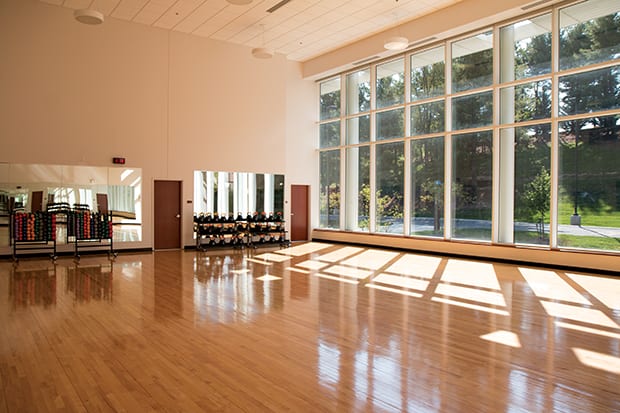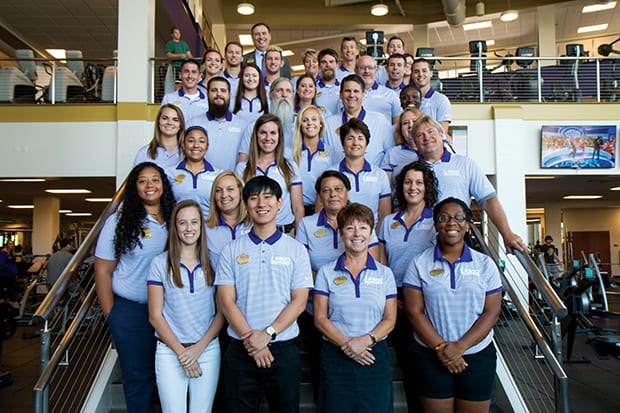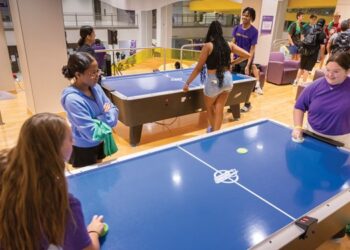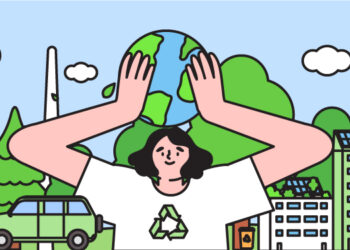“Collegiate recreation programs are like snowflakes: I have never seen two exactly alike,” remarked Eric Nickel, the director of University Recreation at James Madison University (JMU).
Like those unique frozen water droplets, each collegiate recreation program has its defining features that set it apart, from the small private colleges to a large state school. JMU is no different as it has grown and altered over the past two decades. According to Nickel, the transformation was possible because of resources provided by a supportive administration and a commitment to student learning and development in every aspect of the program.
In fact, the university’s recreation center is one of the most stunning views of the JMU campus. Driving down I-81 through Harrisonburg, Virginia, it’s snuggled in the Shenandoah Valley, with mountains surrounding the university on all sides. While the interstate intersects campus, a walking bridge and tunnel connects one side of the university to the other. As you make your way down the interstate, an enormous building resembling a Japanese steakhouse appears.
No, the students do not have a giant Benihana on campus; rather it is the newly renovated and expanded University Recreation Center (UREC). The facility was initially constructed in 1995, when University Recreation was first establishing an identity on campus.
“We had a rare opportunity to be able to re-create ourselves in 1995, revising our mission, culture and set of values on which to build this new vision for recreation at JMU,” explained Nickel. “We were provided the resources to increase our full-time staff from five to 18 people in 1995 — [we now have 28 full-time professionals] — and bring a lot of new energy and ideas to our campus. That first staff — many of whom are now directors at other institutions — brought a passion for bringing our new model to life and making our center a more central component to campus life here at JMU.”

“We were literally locking doors and having lines to get into certain fitness spaces,” he explained. “During peak demand times of the day, the building was just over capacity. We spent a lot of time developing the healthy routines of our students and the last thing we wanted to do was have them wait in line to get on the fitness equipment. We saw it coming over a number of years, but it reached critical mass specifically about five years ago.”
Nickel took the university administration, students and staff to tour numerous recreation centers throughout the country to determine the wants and needs for the facility. “We knew we needed an addition, but we didn’t really know the scope at that point,” he said. “Turns out it was a 100 percent addition. We doubled the building from 141,000 square feet to 280,000. We laid out a program that would hopefully take us through the next decade. We were fortunate we were afforded the resources to do that. We didn’t cut anything out of our program plan we had developed.”
The new and improved UREC opened in two phases, starting with the addition opening in January 2016 and the renovation eight months later in August 2016. Prior to the addition and renovation, University Recreation already had extremely high participation rates, reaching about 92 percent of students on campus. With such high engagement, the staff did not expect to see a huge increase once the updated facility opened.
“We didn’t think that frequency of use would go up that much, but in the first year of operation we are already up to an average of 1,000 students a day,” said Nickel. “We cracked 6,000 students a day several days this winter. Before, the record was around 4,000. With the new spaces, new programs and not having to wait in any lines, they have responded well to it.”
Like snowflakes that are made up of thousands of ice crystals, the UREC isn’t defined just by one thing. There are layers and patterns that have combined to form something truly unique. But, if you ask any of the UREC professional staff what makes their program exceptional, their answer will be the same: a commitment to student learning and development.

This sentiment was echoed by Nickel. He explained when developing their mission and vision they referred to the Student Learning Imperative, originally submitted by Dr. George Kuh, the director of the National Institute for Learning Outcomes Assessment. “It addressed the need for Student Affairs divisions within higher education to view themselves as educators and for units within these divisions to be intricately woven into the fabric of the academic learning mission of the institution,” he said. “So we asked ourselves, ‘What would our programs and services look like if they were based on a learning model, rather than a simple participation model that was pervasive at the time?’ We asked, ‘Where are the opportunities we could teach our ‘curriculum’ to develop the knowledge, skills and abilities of our students at JMU?’”
JMU University Recreation has made it a priority to create programs that provide learning outcomes. But it’s not just traditional programs such as exercise; it’s also other important areas like nutrition, sportsmanship, teamwork and injury prevention. “We had a vision to create learning outcomes for most everything we do, so that we could be intentional about our students’ learning,” added Nickel. “This resulted in some programs, services or operating methods to be discontinued and many more to be added. We found starting with what students will learn from our program and services allowed us to focus on the things we thought would create a well-rounded JMU student and enhance their classroom learning here at JMU.”
Keeping these learning outcomes in mind impacted the renovation and addition process. Adding fitness space was a necessity, but it was also key to create innovative spaces that fostered these learning outcomes. Some of these spaces include the demonstration kitchen, adventure center and athletic training services.
“When we created new fitness spaces in the addition, it allowed us to retrofit the spaces in the 1996 building for a lot of things not en vogue at the time,” said Nickel. “We added a demonstration kitchen. Our staff had been saying how difficult it was to only deal with the fitness side of health and wellness without addressing nutrition. Now we can teach healthy cooking to our students here. We also built an athletic training room. A lot of programs started providing certified athletic trainers for their sport clubs. We went a step further and provided it for drop-in users, any student participant in the rec center.”
These new innovative spaces and programming aid in “Motivating Madison into Motion” — a goal that remains at the forefront for the UREC staff. Looking into the future, Nickel hopes the UREC will continue to engage all JMU students and help them achieve not only their academic goals, but develop a healthy lifestyle they can take with them wherever they go.
“The goal for us is to engage 100 percent of the student body, 100 percent of Madison graduates, into healthy lifestyle habits,” said Nickel. “How do we give them the knowledge, skills and abilities to leave having developed a healthy lifestyle they can maintain for the rest of their lives? That requires a lot more of an individualized plan because that one-size-fits-all model really doesn’t apply anymore. So developing these supportive services like personal training, athletic training and nutrition classes help people explore all of the options out there. The idea of, ‘How do we engage every student?’ is the future for us here at JMU.”












